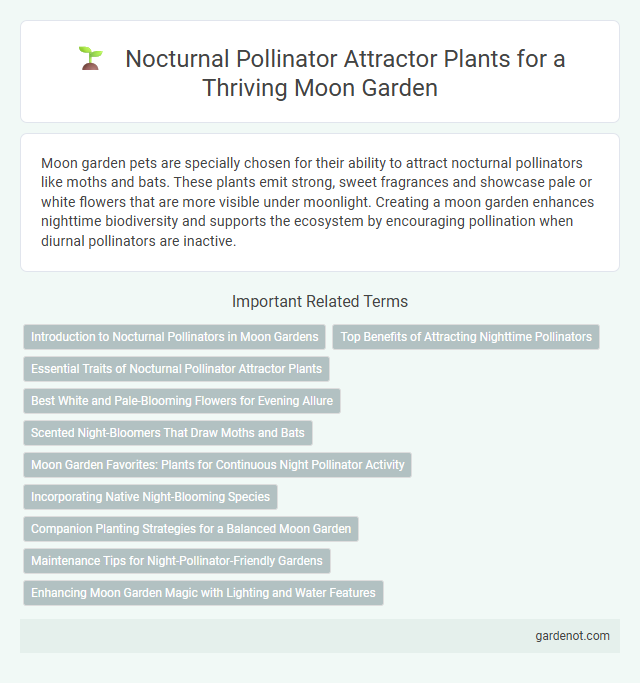Moon garden pets are specially chosen for their ability to attract nocturnal pollinators like moths and bats. These plants emit strong, sweet fragrances and showcase pale or white flowers that are more visible under moonlight. Creating a moon garden enhances nighttime biodiversity and supports the ecosystem by encouraging pollination when diurnal pollinators are inactive.
Introduction to Nocturnal Pollinators in Moon Gardens
Moon gardens are designed to attract nocturnal pollinators such as moths, bats, and night-flying beetles that play a crucial role in nighttime plant pollination. These gardens often feature fragrant, pale-colored flowers like moonflowers and evening primrose that enhance visibility and scent dispersion after dark. Incorporating plants that bloom at night stimulates biodiversity and supports ecosystems by providing essential resources for nocturnal pollinators.
Top Benefits of Attracting Nighttime Pollinators
Attracting nocturnal pollinators like moths and bats enhances the biodiversity of a moon garden by promoting the pollination of night-blooming flowers such as evening primrose and moonflower. These pollinators contribute to higher fruit and seed production, improving garden yield even in low-light conditions. Supporting nocturnal pollinators also helps maintain ecological balance and increases nighttime garden activity and interest.
Essential Traits of Nocturnal Pollinator Attractor Plants
Nocturnal pollinator attractor plants exhibit essential traits such as strong, sweet fragrances released at night, pale or white-colored flowers that enhance visibility under low light, and abundant nectar production to sustain night-active insects and bats. These plants often have tubular or bell-shaped flowers adapted to the feeding mechanisms of moths and other nocturnal pollinators. Their bloom timing typically aligns with nighttime activity to maximize pollination efficiency in moon garden ecosystems.
Best White and Pale-Blooming Flowers for Evening Allure
White and pale-blooming flowers like gardenias, moonflowers, and evening primroses emit strong fragrances and reflect moonlight, making them highly effective for attracting nocturnal pollinators such as moths and bats. These blooms' pale colors enhance visibility in low light, optimizing pollinator interaction during nighttime hours. Incorporating species like Nicotiana, night-blooming jasmine, and pale dahlias ensures sustained nocturnal allure and supports local ecosystem pollination cycles.
Scented Night-Bloomers That Draw Moths and Bats
Moon gardens featuring scented night-bloomers such as evening primrose, night-blooming jasmine, and nicotiana effectively attract nocturnal pollinators like moths and bats. These plants release intense fragrances at dusk, signaling nectar availability and guiding pollinators in low-light conditions. Incorporating species with strong nighttime scents enhances biodiversity and supports essential pollination during nighttime hours.
Moon Garden Favorites: Plants for Continuous Night Pollinator Activity
Moon Garden favorites like Nicotiana, Evening Primrose, and Night Phlox play a crucial role in attracting nocturnal pollinators such as moths and bats, ensuring continuous night pollinator activity. These plants emit strong, sweet fragrances and produce pale or white blooms that enhance visibility under moonlight, strategically adapted to nighttime pollinator preferences. Incorporating species with staggered blooming periods guarantees sustained nectar availability, promoting a healthy ecosystem support for nighttime pollinators.
Incorporating Native Night-Blooming Species
Incorporating native night-blooming species such as evening primrose, moonflower, and night-blooming jasmine enhances a moon garden's appeal by attracting nocturnal pollinators like moths, bats, and nocturnal bees. These plants emit strong fragrances and produce nectar during nighttime hours, providing essential resources that support local ecosystems. Utilizing native species ensures better adaptation to local climate and soil conditions, promoting sustainable growth and increasing nocturnal biodiversity.
Companion Planting Strategies for a Balanced Moon Garden
Moon garden companion planting strategies enhance nocturnal pollinator attraction by integrating night-blooming flowers such as evening primrose and night phlox, which emit strong fragrances and vibrant colors visible under moonlight. Incorporating herbs like lavender and rosemary not only supports pollinator diversity but also balances pest control through natural repellents. Strategic placement of these plants creates a harmonious ecosystem, ensuring continuous nectar availability and promoting a thriving moon garden environment.
Maintenance Tips for Night-Pollinator-Friendly Gardens
Incorporate night-blooming flowers such as evening primrose and moonflower to attract nocturnal pollinators like moths and bats. Avoid using pesticides and opt for organic fertilizers to maintain a healthy habitat that supports these beneficial insects. Provide water sources and minimize artificial light pollution to encourage active nighttime pollination in your moon garden.
Enhancing Moon Garden Magic with Lighting and Water Features
Incorporating soft LED lighting and reflective water features amplifies the allure of nocturnal pollinators like moths and bats in a moon garden, creating a captivating nighttime ecosystem. Strategic placement of solar-powered lanterns near fragrant blooms encourages active pollination while ensuring minimal light pollution to protect sensitive species. Water elements with gentle ripples provide essential hydration and attract pollinators, heightening biodiversity and sustaining the garden's magical ambiance after dusk.
Nocturnal pollinator attractor Infographic

 gardenot.com
gardenot.com